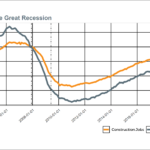Do We Need A Permanent Shift in Service Employment?

Employment in January grew by a disappointing 49,000 new jobs to a total of 142.6 million.
Average monthly job growth absent a global pandemic would typically be 300-400% higher and average job growth at the start of the post pandemic recovery was over 2,000% higher, averaging over 1.5M jobs created each month for the first few months of the recovery.
While the unemployment rate dropped slightly – from 6.7% to 6.4% – it is not the most important economic metric right now. Economists normally love to use rates (like the unemployment rate) instead of levels (like the total number of jobs) because rates can help control for time and scale; however, the pandemic recovery is one of the rare periods when the rate does not particularly matter. What matters right now is the total employment level, particularly because we know that our economy – based on demographics, technology, business models, supply chains, employment training, etc. – is capable of employing 153 million people, since that is what it was doing a year ago before the onset of the pandemic!
This means we know the economy is missing at least 10 million jobs relative to its full potential.
January Was Better Than December, but…

December’s adjusted job count shrunk by 227,000 so, as disappointing as January’s job growth was, it was at least better than last month. Regardless, the overall trend is troubling. Employment recovery over the summer, following the immediate economic impact of Covid-19, was strong, but it has been sequentially shrinking over the fall and into the winter.
A Shift in Service Employment?

Leisure and hospitality service jobs are still being hit hard. The question then for policy makers, educators and business leaders, as well as people still struggling in the labor markets, is: are the missing 10 million jobs still coming back? Or did Covid-19 change our underlying economy so much that they’re gone for good?
Unfortunately, the shrinking economic expansion suggests a higher probability of the latter than the former.
The silver lining to this, however, is that housing remains a strong sector in the economy not just in relative terms, but in absolute terms as well. The industry has opportunities for both career growth and high job satisfaction. (Our annual Skilled Trades in America Report covers the opportunities and high levels of satisfaction in the industry.) We have an opportunity in front of us to transition more careers from other sectors into the skilled home trades .







 Press & Media Inquiries
Press & Media Inquiries Angi Economics
Angi Economics